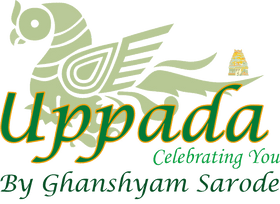About Us
A Promise Woven in Community & Craft
Welcome to Uppada.com. We are more than a brand; we are a living library of India's most cherished textile traditions. Our journey is one of passion, partnership, and a deep-seated desire to bring you authentic, handcrafted treasures directly from the communities that create them. This is our story.
Our Tapestry of Indian Crafts
Our passion for handlooms has taken us on a journey across the nation, forging partnerships with master artisans to bring you authentic crafts directly from their geographical heartlands. Our collection is a celebration of this diversity:
- Uppada & Khadi Jamdani Sarees: From the coastal towns of Tuni, Kakinada, and Srikakulam in Andhra Pradesh, our looms bring you the feather-light elegance of Uppada silks and the soulful, breathable beauty of Khadi Jamdanis.
- Paithani Sarees: We travel to the historic looms of Yeola, Maharashtra, where some of our very intricate designs are weaved by the master weavers and bring to life a magnificent Paithani silk canvas adorned with gold and colourful nature-inspired motifs.
- Bandhani & Shibori: Our journey takes us to the vibrant desert communities of Bhuj, Kutch, for the joyful dot-patterns of Bandhani, and to Rajasthan, where artisans master the intricate resist-dyeing technique of Shibori.
- Hand-Painted Kalamkari: From the revered temple town of Sri Kalahasti, Andhra Pradesh, our master artists hand paint the exquisite Kalamkari, Each intricate line they draw is a testament to a narrative tradition passed down through centuries, making them not just an artist, but a storyteller for the ages.


Our Heartbeat: The Looms of Narayanpet
Our story begins in our ancestral home in Narayanpet, Telangana. This home is not just a building; it's the soul of our brand, it beats with the rhythmic sound of handlooms—a sound that has echoed through our family for generations. This home is the heart of our craft, where tradition isn't just remembered; it's lived every single day.
It is here that our master weavers, with hands guided by decades of skill, bring to life the exquisite elegance of Uppada Jamdani and the timeless grandeur of Gadwal silk sarees. We are one of the few who manage every step of the creation process under one roof. From our in-house dyeing unit, where colours are mixed to perfection, to the final intricate weave on our looms, every saree is a testament to our commitment to quality and authenticity.
Our passion extends beyond the loom to the ancient art of Kalamkari. We believe in creating pieces that are as kind to the earth as they are beautiful. Every hand-painted Kalamkari creation—be it a saree, dupatta, or fabric—is coloured with 100% natural dyes, sourced from the bounty of nature around us.
What makes this process truly special is that it is powered entirely by the incredible women of our community. From preparing the fabric canvas, to meticulously drawing the intricate designs, and delicately filling in each colour by hand, their skill, patience, and spirit are the soul of our Kalamkari art.
The Purity of Our Materials
We believe that a masterpiece begins with the finest ingredients. This principle is at the core of everything we create.
- For Our Weaving: We provide our artisans across the country with the best raw materials available. This includes lustrous mulberry silk, pure, breathable cotton, and authentic, high-quality zari. By ensuring the quality of the inputs, we honour the skill of the weaver and guarantee a final product that is both beautiful and durable.
- For Our Kalamkari: Our commitment to nature and tradition is absolute in our Kalamkari art. Every piece is painted using only 100% natural dyes derived from the earth. Hues of black, red, yellow, and blue are born from materials like jaggery, iron fillings, pomegranate peels, turmeric, and indigo, making each creation safe, eco-friendly, and truly one-of-a-kind.


Empowering Our Artisan Partners
Our relationship with our weavers is a partnership built on respect, trust, and shared success. We see ourselves as a bridge connecting their timeless skills to the modern world. We empower them by:
- Sharing Market Knowledge: We work closely with our artisan communities, sharing valuable insights into contemporary designs, colour palettes, and customer preferences. This collaboration ensures their craft remains relevant and cherished.
- Providing Quality Raw Materials: By ensuring a steady supply of premium raw materials, we remove a significant burden from the weavers, allowing them to focus on what they do best: creating magic on the loom.
Building a Community of Craft
Preserving our textile heritage means investing in its future. We are deeply committed to nurturing the next generation of artisans through dedicated skill development and training.
- In Partnership with NABARD: In Narayanpet, we are incredibly proud to partner with the National Bank for Agriculture and Rural Development (NABARD) to conduct skill development programmes. These initiatives train new people, especially women, in the intricate art of Kalamkari, providing them with a sustainable livelihood.
- In Collaboration with the Weaver Service Centre: We also work with the government's Weaver Service Centre to organize specialized training for our weavers. These sessions help them refine their techniques, improve efficiency, and ultimately enhance their earning potential.

Our Promise to You
When you choose a piece from Uppada.com, you aren't just buying a product; you are inheriting a piece of history. You are supporting a community of master artisans and empowering women to be the custodians of a precious legacy.
We invite you to explore our collection and wrap yourself in a story of tradition, artistry, and purpose.

